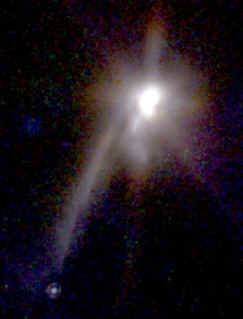Pulsars "Lie" About Their Ages
-- Another Hit For Hoagland's Hyperdimensional Physics Model
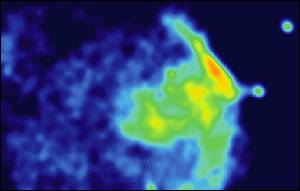
Pulsar B1757-24 exiting a supernova
shell
In an extraordinary finding released in the scientific journal Nature, two New Mexico researchers have found that the apparent age of a pulsar in the constellation Sagittarius is far older than expected. This single finding has shattered three-decades-old concepts of how these exotic stellar objects are formed and operate. These new observations not only completely confound the conventional physics models, but they also reinforce and validate a specific prediction made by Enterprise principal investigator Richard C. Hoagland more than a decade ago.
At that time, Hoagland and Erol Torun published the first paper on what would later become known as "Hyperdimensional Physics." Based on Torun's work on the internal geometry of the D&M pyramid and Hoagland's complimentary work on the Cydonia Geometric Relationship Model, this paper "The Message of Cydonia," showed that the purpose of the Monuments of Mars was to inculcate the knowledge of this physics to those that found the ruins at Cydonia. The ideas presented in that paper, based on the "tetrahedral physics" implied by the alignments of the ruins, led to Hoagland and Torun making a number of observations regarding planetary energy emissions and their preference to center near the "tetrahedral latitude" of 19.5°. These observations of other bodies in the solar system implied that the planets and moons were receiving energy from an outside source -- higher dimensions. Eventually, Hoagland and Torun used this data to propose a hypothesis about the source of this excess planetary energy and used that hypothesis to make a specific prediction regarding the (then upcoming) Voyager II flyby of Neptune. This prediction, that the magnetic "North" pole of Neptune would be found to be in the planet's Southern geographic hemisphere, turned out to be correct. At that time, critics argued that a single prediction, no matter the source, was insufficient to take the whole field of Hyperdimensional Physics seriously.
What they ignored was that embedded in the text of the paper was a second, highly crucial prediction of the Hyperdimensional model. A key aspect of this idea from the beginning was the concept that angular momentum, the energy created by the rotation of the sun and planets and their orbits around the sun, was much more influential on the entire system than their relative mass. Under the conventional model, the sun is the most influential body in the solar system because it contains over 98% of the total mass. Yet it conversely retains only 1% of the angular momentum. It is this single measurement of energy output, angular momentum, that led Hoagland and Torun to make this observation back in 1989.
"... the authors feel they would be remiss if they did not conclude by at least mentioning two additional areas where future observations could greatly increase our confidence in the reality of this phenomenon [Hyperdimensional Physics] -- if not our understanding of its nature. In view of apparent solar conformance with "circumscribed tetrahedral geometry," one area for further research seems immediately apparent: "exotic stars." In addition to "flare stars" and other highly-variable stellar objects with surface phenomenon thought to be similar to solar processes, we feel that, if the Cydonia mathematics are attempting to describe not only energy "flow" but somehow "energy generation" -- then the ability to test these ideas via radio astronomy should be the highest in terms of one class of exotic objects in particular: pulsars. The common link connecting all the objects for which the Cydonia "embedded tetrahedral model" seems to work -- from the planets to the Sun--seems at this stage to be based on one significant association: angular momentum and magnetic fields. Before the adoption of the present, complex "self-excited dynamo theory" (with internal, circulating, conducting "fluids" as the mechanism for general planetary and stellar magnetism), another -- strictly empirical -- hypothesis was proposed: a strikingly simple relationship between the observed total angular momentum of the object, and a resulting dipole ...
... Even the "average" spinning neutron star (the favored "pulsar model") possesses surface gravitational accelerations, angular momentum, and magnetic field strengths billions of times more intense than similar quantities in any solar system object. Moreover, since Schuster's Hypothesis strikingly succeeds in its prediction of even these extraordinary magnetic dipole moments (see Fig. 8), we cannot help but wonder at what rich new confirmations of the "Cydonia mathematics" may lie hidden in existing -- and currently mystifying -- pulsar observations . . ."
In short, according to Hoagland and Torun, pulsars, because of their incredible angular momentum and magnetic properties, should be excellent Hyperdimensional Physics test beds. In fact, in the case of one pulsar, B1757-24, they may be a major key in validating the Hoagland/Torun/Bearden/Depalma model.
First, let's look at what pulsars are thought to be in the conventional model.
Stars are assumed to be "born" from spinning gas and dust nebulae. As they contract (under gravity), like an ice skater tucking in her arms, they must spin faster. This is the central tenet of a fundamental law of (current!) physics, called "the conservation of angular momentum." The only way a star is supposed to be able to get rid of this fixed (and assumed "constant") quantity of angular momentum transferred to it at birth, is to "re-transfer" the momentum to space through one of basically two means: direct mass loss; and/or magnetic interactions (accelerations) between the star and any surrounding nebulae or other nearby assemblages of matter [better known as a "companion set of planets" (or another orbiting star)].
For most of a star's "main sequence" life, the period when it is assumed to be relatively stable in its spin and energy output (although the Hyperdimensional model states that this output is not constant or stable -- but that's another argument), these mechanisms are supposed to be able to transfer at best a few percent of the star's original angular momentum (in theory). So, a star at the end of its life is supposed to have pretty much the same quantity of angular momentum as it was originally "born" with.
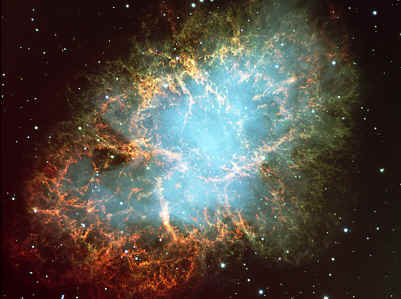
When a massive star (between 5 and 20 times the mass of the sun) reaches the end of its life (defined in the conventional models as "the exhaustion of its nuclear fuel"), it explodes. Such an explosion is called a Supernova. In these models, roughly 90 percent of the outer parts of the star leaves by this means (ultra-rapid mass transfer into space -- in excess of 5000 miles per second!), leaving the remaining, collapsed, ultra-dense core behind, as a now rapidly spinning (under the rigid law of "the conservation of angular momentum," because it has collapsed) "neutron star." Such spinning, incredibly dense objects (essentially, the mass of the sun and the density of an atomic nucleus, smashed into a volume about the width of a small city) are supposed to be at the heart of the "pulsar phenomenon."
Thus, when "born" in this violent end-process of stellar evolution, such a rapidly spinning object is supposed to have been given (through the previous mechanisms) a finite quantity of angular momentum ... not as much as the original star (because of the large fraction of mass lost in the explosion, taking that angular momentum with it) ... but just as finite.
In the ensuing "pulsar phenomenon," such a spinning, highly magnetized object is far more likely to interact with other near-by gas clouds, etc., than the original star. This is because the original magnetic field of the whole star is also supposed to be conserved, and is now collapsed down to the new volume of a "city-sized" object -- from an original volume perhaps several trillion times as large. Such incredibly high-strength magnetic fields are then supposed to be able to accelerate matter still in the vicinity of this newly-born, rapidly spinning object (the outwardly exploding shell of the original star!) -- and fling some of it away from the star via "magnetic acceleration" -- at an appreciable fraction of the speed of light! This phenomenon is what's supposed to create the accelerating beams of matter that spin with the rotation of the star (up to a hundred times per second) -- producing the rapidly rotating, ultra-stable "light house effect" of radio, gamma ray, and optical emissions that characterize the "pulsar phenomena" ... seen even thousands of light years away ...
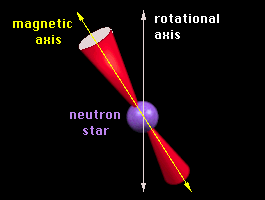
If a planet, like the earth, is in line with these beams of matter, then we can "see" the lighthouse effect. If it is not, we will never spot the pulsar.
In this model, because such an exotic, rapidly spinning, comparatively tiny object (but with the mass of the sun!) is heavily interacting (through its now incredibly strong surface magnetic fields) with the still slowly (comparatively speaking!) expanding shell of its own outer layers (from the original Supernova explosion), it should also be transferring -- at a measurable rate -- its own (finite -- remember, in this model!) angular momentum to the larger cloud. This has to inevitably result in a slow, steady (and observable) "spin down" of the neutron star.
Radio, optical and x-ray/gamma ray observations of the almost 1000 known pulsars discovered since 1968 have measured this "spin down" effect in a wide variety of situations. The incredibly-regular radio, optical and x-ray/gamma ray pulses emitted by such stars have been observed time after time to slowly lengthen by a tiny, but measured amount over several years -- an indication of a (ultra-slow) "despinning" of the tiny stars. Using the (assumptive) law of "the conservation of angular momentum," this steady "spin down" is viewed as confirmation not only of the known laws of angular momentum, but also as a means to "date" the ages of these stars, a kind of "pulsar clock." (Like radioactivity -- with a presumed constant half-life.) Enter the new Very Large Array observations of the pulsar in Sagittarius reported by the BBC.
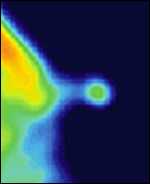
Because about half of all known stars are binaries, when one of these stars explodes as a Supernova it releases itself and its companion in opposite directions ... at whatever the original orbital velocity was between them. In the Sagittarius pulsar, the fleeing pulsar eventually flew right out of the slowly expanding shell of gas from the original explosion (the expanding blast wave ran into an interstellar cloud and slowed way down; the neutron star core didn't ...). Using the known distance, space velocity, and geometry of the pulsar/cloud relationship, the new VLA measurements of the actual space velocity of this pulsar was discovered to be only about 300 miles per second -- way below the estimated 1000 mps previously assumed.
From the observed "spin down rate," the previous estimate of the age of the neutron star/pulsar (when the original Supernova exploded) was ~ 16,000 years. But ... from the "kinemetic" age of the star (measured by its known velocity beyond its own expanding envelope), the age of the original explosion is now estimated as happening ~ 170,000 years ago ... a factor of ten disparity!
Since the now-measured space velocity of the pulsar is not open to any alternative interpretation (it's a REALLY simple measurement, as compared to the model for a despinning pulsar), the age since the pulsar's formation (and separation from its binary companion) must be about the same: 170,000 years. So, for 170,000 years this pulsar has been on its own. Yet, the rate at which its rotation is slowing indicates a much younger age! Obviously ... something is radically wrong with the pulsar model of "a finite amount of angular momentum ... slowly being expended."
The simplest explanation for this "impossibility" is that the star has been able to tap into a previously unknown source of angular momentum ... which has been "trickle charging" the spin of the neutron star even as it's acceleration of charged particles in its beams has been draining it -- at a rate which has extended the pulsar's active life approximately ten times the observed "rate" of deceleration. Such an "unknown source" of energy is precisely predicted by the Hyperdimensional model -- which says that the more angular momentum an object initially possesses, the more it can "tap" into this invisible source of energy to maintain that momentum against known 3-D transfer mechanisms. The actual mechanism for maintaining the pulsar's spin is probably the conversion of the star's precessional energy (which, in DePalma's experiments, is not contingent on a nearby gravitating companion) into rotational energy ... An apt analogy would be a bathtub, with a hole in it. Water is flowing out of the hole at an observed rate. But, unknown to the "observers," there is a hidden plumbing (!) network, refilling the tub at a rate which almost (but not quite) replaces the water lost through the hole. The result is a significantly extended "lifetime" for the bathtub reservoir ... but with no obvious sources of the "refilling!" Result: the water in the tub drains out a LOT slower than it should, even though the rate of water through the hole is well-known ...
There is, flatly, no other explanation for this "extra" angular momentum in pulsar B1757-24. Unlike anything that may be dreamed up by the conventional theorists in an after the fact attempt to patch up their broken theory, the Hyperdimensional model not only implicitly, but Hoagland and Torun specifically, predicted exactly this sort of finding. This now makes two specific predictions of Hoagland's Hyperdimensional Physics model -- a model based on the supposedly meaningless (according to our critics) tetrahedral alignments of the Monuments of Mars -- that have been confirmed by empirical observations.
Of course, these same critics will argue, just as they did with the Neptune pole prediction, that two specific predictions is not enough to consider Hoagland's work seriously. This game, a typical means of protecting the mainstream, is cited by astronomer Halton Arp, author of "Seeing Red" ...
"No matter how many times something has been observed, it cannot be believed until it has been observed again."
Ahem.
Readers of this site will recall that in 1993 Hoagland was awarded the International Angstrom Medal for Excellence in Science by the Angstrom Foundation, in Stockholm, Sweden. This medal was awarded for his work in the field of Hyperdimensional Physics. After discussions with a number of other researchers involved in similar fields, Stan Tenen, Thomas Bearden and Dr. Bruce Depalma, Hoagland published in 1998 his follow up to the "Message of Cydonia." Known around here simply as "The Hyperdimensional Physics paper," (Hubble's New "Runaway Planet": A Unique Opportunity for Testing the Exploding Planet Hypothesis and ... Hyperdimensional Physics) it laid out three more specific tests of the Hyperdimensional theory.
1) Additional Solar System Members -- Because there is insufficient measurable angular momentum in the observable solar system members to account for the sun's energy output, the Hyperdimensional model implies that there may be at least one massive (Jupiter plus sized) undiscovered solar system member or two smaller ones, possibly in retrograde orbits. (For a full explanation see the "Hyperdimensional Physics paper).
Status - This prediction was well on its way to being confirmed even before we discovered a 1982 front page article in the Washington Post. (Page1 - Page2) The article interviewed JPL's Gerry Neugebauer about an object spotted in Orion by the IRAS infrared satellite that was estimated to be 50 billion miles from Earth. This object fits Hoagland's prediction within very tight parameters. To date, no follow up observations or papers have been published on this object, and in inquires to Dr. Neugebauer, he stated the quotes in the story were "taken out of context. I do not know about it nor any follow-up."
In 1999, evidence for yet another solar system member in Sagittarius was cited in several news reports. Both of these observations show that Hoagland's prediction of additional planets found at great distances from the Earth is well on the way to being verified.
2) HD energy generation in both planets and stars should be -- must be -- variable. This is simply implicit in the mechanism which generates the Hyperdimensional energy in the first place: ever changing hyper spatial geometry. Unlike other efforts to explain anomalous planetary energy emissions via continued "planetary collapse," or "stored primordial heat," the Hyperdimensional approach specifically predicts one radical, definitive observational difference from all other existing explanations--
Look for small, short-term amplitude-variations in the infrared emission levels of all the giant planets ... synchronized (as are the still-mysterious motions of the GRS on Jupiter) with the orbital motions and conjunctions of their moons.
Status - There are many supporting observations for this concept. The observation of variable stars has been going on for decades, and this class of stars has remained somewhat of a mystery. In addition, recent observations have given rise to the notion that otherwise stable "main sequence" stars can suddenly and unpredictably (in conventional terms) erupt, either in major short term flares or even in irregular mini novas. Our own sun has shown recently that the previously assumed and comforting "solar constant" is anything but. In the Hyperdimensional model, these "unpredictable" solar eruptions become part of predictable cycles, related to the Hyperdimensional geometries.
There have been no recent published data on the excess energy output of the "gas giant" outer planets since the Voyager missions of the 1980's, even though new generations of Earth-based telescopes -- including highly sensitive new infrared facilities -- are now capable of making significant improvements over those insitu spacecraft measurements, this time repetitively from Earth! In the event that this data is ever released, a change in the overall output (or cyclic variations in that output!) as Hoagland has repeatedly said, would be another dramatic confirmation of the Hyperdimensional model.
3) Extrasolar Planet Systematic spectroscopic observations (carried out over days or months), to detect the presence of any satellites of this proposed Jovian-type world. TMR-1C, the Extrasolar planet discovered and announced by NASA amid much fanfare in 1998, would be an ideal test bed for the Hyperdimensional model. Successful detection of a "Mars" or "Earth" (or any significant satellites) orbiting this "new planet" would immediately present possibilities for carrying out the same variety of HD tests proposed (above) for the outer planets of this solar system, starting with -- detection of distinct variations in the "new planet's" own infrared emissions -- synchronized with the calculated orbital periods of any detected satellites (or resonance's thereof ...). This would offer immediate, compelling evidence for the general correctness of the "Hyperdimensional Model" ... especially, if such IR signatures could be matched with similar types of time-varying emissions observed radiating from the giant planets of this solar system ...
Status - Recently, NASA has sought to downplay the possibility that this object is a newly forming planet. Claiming that since it is too bright and hot to be a planet it therefore "must" be a far distant star ...
The problem for this idea, besides the fact that the object has a clear filament of material stretching back to the source binary system from which it was ejected, is that it requires a number of complex coincidences to make it work. In the "distant star" model, the object just happens to be right at the end of this light beam of material, by pure coincidence. And, since it is actually too faint to be a star, it must be being filtered through a dense fog of interstellar dust. This object is a "tweener," too bright, hot and energetic to be a planet in the conventional methodology, but too faint and weak to be a star either, requiring the baseless a posteri assumption of an intervening "dust cloud." Unfortunately, no evidence exists for this mysterious "cloud" obscuring our view of this "star." It is merely assumed to exist because the object would have to be much brighter if it was really a star. The reality is that it is not the planet that has a problem, but rather the model that NASA is working from and the assumptions contained therein.
Enter the Hyperdimensional model.
If the Hyperdimensional model is correct, then by implication "proto planets," like TMR-1C was initially assumed to be, must contain far greater energies than are possible in the Newtonian/Enisteinian Relativistic models. The reason for this is the same as for the pulsar "lying" about it's age -- angular momentum. Because newly forming rotating spheres (like planets) posses the majority of their angular momentum at the beginning of their life cycles, by implicit prediction of the HyperD model they will be significantly brighter and hotter (because they are accessing higher dimensional energies) than the conventional models would assume. So this sort of excess energy is exactly what would be expected from an observation of a newly forming planet.
If observations of TMR-1C continue, then a further specific prediction is that it's luminosity and heat will start to vary, probably by a considerable degree. As the planet continues to speed away from its parent binary system (at about 1,000 miles per second) it will change the hyper spatial geometries, and hence the energy the object is drawing from these higher dimensions.
One other aspect of the Hyperdimensional model that is gaining support is the notion that there is no inherent "speed limit" to the universe. In a core pillar that the HyperD model shares with Dr. Tom Van Flandern's "meta model," HyperD Physics allows energy to traverse the intervening hyper spatial topologies in a way that would appear to exceed the speed of light. This aspect of the theory has been bolstered by recent experiments conducted at the private NEC Institute. In the experiments, researchers fired a laser pulse into a glass chamber filled with a vapor of cesium atoms and the light pulse "arrived" at the other end before it actually left. Unlike an earlier Phase-Conjugate optical phenomenon called "Tunneling," which has supposedly been "explained" in quantum terms, these experiments unambiguously show that as Lijun Wang, the principal author put it, "... the generally held misconception that `nothing can travel faster than the speed of light' is wrong."
In any event, both these phenomena not only totally discredit Newtonian/Enisteinian Relativistic physics, the basis of which is that the speed of particles of light in a vacuum is the only absolute measurement in the universe, but they also have grand implications for the Hyperdimensional model.
Wang's experiment, in fact, is flatly nothing more than a Hyperdimensional Physics experiment. In it, he used two interfering light waves to produce his superluminal effect. Although they have tried to attribute the faster than light effect to the cesium atoms "gain assisting" the wave pattern of the light, in fact what they have produced is a Hyperdimensional effect. Followers of Tom Bearden's work on "Scalar Wave Interferometry" will note that this sort of experiment is exactly how he proposed to produce a superluminal effect. For his part, Wang is somewhat vague about his explanation of the phenomena, attributing it to an "anomalous dispersion region" in the wave pattern and describing it as a "rather counterintuitive effect."
"Tunneling" is slightly different animal, but no less Hyperdimensional in it's implications. It occurs in certain solid state electronics and is usually described as as a quantum phenomenon ... "the appearance of electrons on the other side of a [electrical] potential barrier ... without them apparently traveling through the intervening distance." The problem is this is a "post priori" explanation for the observed phenomenon. It actually explains nothing.
The electrons just "appear" some place where conventional ("sanitized" 19th Century) physics says they shouldn't. So ... did they "magically" travel through the intervening space, or, did they "disappear" at one location ... and "reappear" at their new location, having been literally "recreated" (by some currently unknown physics) at this new location ... And, if so, how does one count the time between their disappearance and reappearance? Have they truly exceeded light speed in 3-Space (which would require doing something to the properties of that space)? Or, does their destruction/recreation simply reflect a currently unknown set of "higher dimensional/topological" laws indicative of a far more complex state-space structure ... which would automatically exceed three-dimensional limitations ..?
The latter explanation is actually the simplest, since as stated above no explanation exists in the conventional model. Since we already know that gravity propagates faster than light, and even conventional physicists are now admitting that higher dimensions would solve a lot of problems for current physics (see the August, 2000 issue of Scientific American), we must Face the eventuality that the Hyperdimensional model is by far the most consistent and productive.
We must also remember that simply because conventional science observes a phenomenon, and then names it (i.e. "Tunneling" or "anomalous dispersion") this does not constitute an explanation that must be "overturned" or disproven. In both cases, there in fact exists no viable quantum alternative to the Hyperdimensional explanation.
What we are left with is five specific predictions made by Hoagland concerning his Hyperdimensional Physics model, two of which are now verified and and a third which is now well on its way to verification. The remaining two are eminently testable with current instruments and in fact the data may have already been collected, just not released. In addition, the observations of the pulsar B1757-24 are flatly not explainable by the conventional model without yet another after the fact revision to Newtonian/Enisteinian Relativistic physics. Add to that new experiments that confound the assumption that the speed of light is absolute, and there is a clear need for a better, more productive view of physics which actually fits the observable data. Unlike the accepted model of current physics, there is no need for "special Hyperdimensional Physics" to explain the data which contradicts the predictions, because there is no data that contradicts the HyperD predictions. Hoagland's model is simple, predictive, consistent with the data and now verified to a great degree.
And all this, from a theory that derives from a "meaningless" set of alignments between apparently artificial objects on Mars!
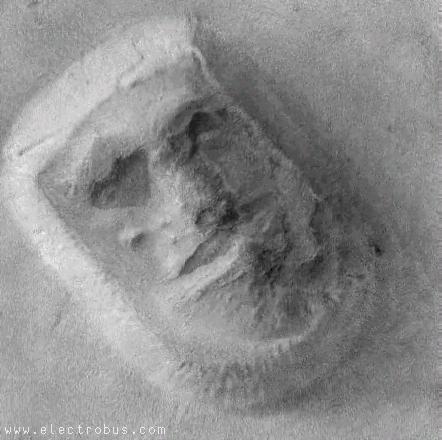
New enhancement and corrected orthographic rectification of
MGS image SP22003 by Mark Kelly
No matter how much the critics hem and haw, it is a straight line from the artificiality of the Face on Mars, to the Cydonia Geometric Relationship model, to the Message of Cydonia, and ultimately to pulsars lying about their ages. You simply can't get to our elegant and now confirmed prediction of the pulsar phenomenon without starting at the Face and stopping along the way to the "meaningless" tetrahedral alignments at Cydonia. If we are wrong about Cydonia, then there is simply no way we can be "right" about the pulsars.
But we are.
And that perhaps is just a little too much for our critics to swallow, although they will try. Next, we'll try to find them a little water to help wash it down ...
